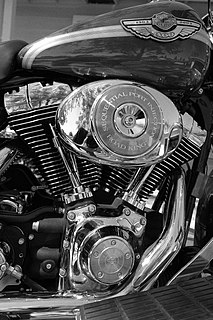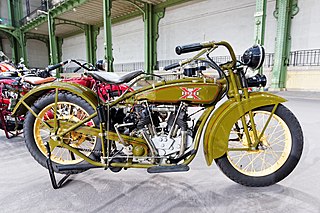
Harley-Davidson, Inc. (H-D), or Harley, is an American motorcycle manufacturer, founded in Milwaukee, Wisconsin in 1903.

A V-twin engine, also called a V2 engine, is a two-cylinder internal combustion engine where the cylinders are arranged in a V configuration. Although widely associated with motorcycles, V-twin engines are also produced for the power equipment industry and are often found in riding lawnmowers, small tractors and electric generators.
Indian is an American brand of motorcycles originally produced from 1901 to 1953 in Springfield, Massachusetts, United States. Hendee Manufacturing Company initially produced the motorcycles, but the name was changed to the Indian Motocycle Manufacturing Company in 1928.
Yamaha Motor Company Limited is a Japanese manufacturer of motorcycles, marine products such as boats and outboard motors, and other motorized products. The company was established in 1955 upon separation from Yamaha Corporation, and is headquartered in Iwata, Shizuoka, Japan. The company conducts development, production and marketing operations through 109 consolidated subsidiaries as of 2012.

The Norton Motorcycle Company is a British motorcycle marque, originally from Birmingham, UK. It was founded in 1898 as a manufacturer of "fittings and parts for the two-wheel trade". By 1902, the company began manufacturing motorcycles with bought-in engines. In 1908, a Norton-built engine was added to the range. This began a long series of production of single and eventually twin-cylinder motorcycles, and a long history of racing involvement.

Velocette is the name given to motorcycles made by Veloce Ltd, in Hall Green, Birmingham, England. One of several motorcycle manufacturers in Birmingham, Velocette was a small, family-owned firm, selling almost as many hand-built motorcycles during its lifetime, as the mass-produced machines of the giant BSA and Norton concerns. Renowned for the quality of its products, the company was "always in the picture" in international motorcycle racing, from the mid-1920s through the 1950s, culminating in two World Championship titles and its legendary and still-unbeaten 24 hours at over 100 mph (161 km/h) record. Veloce, while small, was a great technical innovator and many of its patented designs are commonplace on motorcycles today, including the positive-stop foot shift and swinging arm rear suspension with hydraulic dampers.

A motorcycle engine is an engine that powers a motorcycle. Motorcycle engines are typically two-stroke or four-stroke internal combustion engines, but other engine types, such as Wankels and electric motors, have been used.

There are many systems for classifying types of motorcycles, describing how the motorcycles are put to use, or the designer's intent, or some combination of the two. Six main categories are widely recognized: cruiser, sport, touring, standard, dual-purpose, and dirt bike. Sometimes sport touring motorcycles are recognized as a seventh category. Strong lines are sometimes drawn between motorcycles and their smaller cousins, mopeds, scooters, and underbones, but other classification schemes include these as types of motorcycles.
The Killinger and Freund Motorcycle was an attempt in 1935 by a group of five German engineers from Munich to design a more streamlined and modified version of the German Megola front-wheel drive motorcycle. The work took three years to complete but the result was impressive. The engine displacement stayed the same as the Megola at 600 cc but was much lighter and more simplified than a standard 100 cc motorcycle of the time.

A single-cylinder engine is a basic piston engine configuration of an internal combustion engine. It is often seen on motorcycles, auto rickshaws, motor scooters, mopeds, dirt bikes, go-karts, radio-controlled models, and has many uses in portable tools and garden machinery. Some single-cylinder automobiles and tractors have been produced, but are rare today due to developments in engine technology.
Bigtoe is a motorcycle that once held the Guinness World Record in the category of Tallest Rideable Motorcycle, bearing a maximum height of 7.5 feet and a top speed of 62 mph. It weighs 3,600 pounds. Tom Wiberg, from Sweden, built it in 1998 with a Jaguar V12 engine.

The Excelsior Super X was a motorcycle manufactured by the Excelsior Motor Manufacturing & Supply Company from 1925 to 1931. It was the most famous Excelsior motorcycle manufactured by that company and was the first American forty-five cubic inch motorcycle.
Motorcycle components and systems for a motorcycle are engineered, manufactured, and assembled in order to produce motorcycle models with the desired performance, aesthetics, and cost. The key components of modern motorcycles are presented below.

BMW Motorrad is the motorcycle brand of the German company BMW, part of its Corporate and Brand Development division.

The Indian Scout is a motorcycle built by the Indian Motocycle Company from 1920 to 1949. It rivaled the Chief as Indian's most important model. The 101 Scout, made from 1928 to 1931, has been called the best motorcycle Indian ever made. A second line of Scouts, with heavier frames, was introduced in 1932 alongside the Standard Scout, which replaced the 101 Scout and shared its frame with the Chief and the Four. The small-displacement Scout and the Sport Scout, introduced in 1934, were continued until the end of civilian production in 1942. Military versions of both models were used by US and other Allied forces during World War II.
The NSU Quick 50 was a light motorcycle manufactured by NSU Motorenwerke AG from 1963 to 1965. It was the last motorcycle built by NSU.

A scooter is a type of motorcycle with a step-through frame and a platform for the rider's feet. Elements of scooter design were present in some of the earliest motorcycles, and scooters have been made since 1914 or earlier. Scooter development continued in Europe and the United States between the World Wars.

Kawasaki motorcycles are manufactured by the Motorcycle & Engine division of Kawasaki Heavy Industries at plants in Japan, USA, Philippines, India, Indonesia, Bangladesh and Thailand.

A motorcycle transmission is a transmission created specifically for motorcycle applications. They may also be found in use on other light vehicles such as motor tricycles and quadbikes, go-karts offroad buggies, auto rickshaws, mowers and other utility vehicles, microcars, and even some superlight racing cars.














